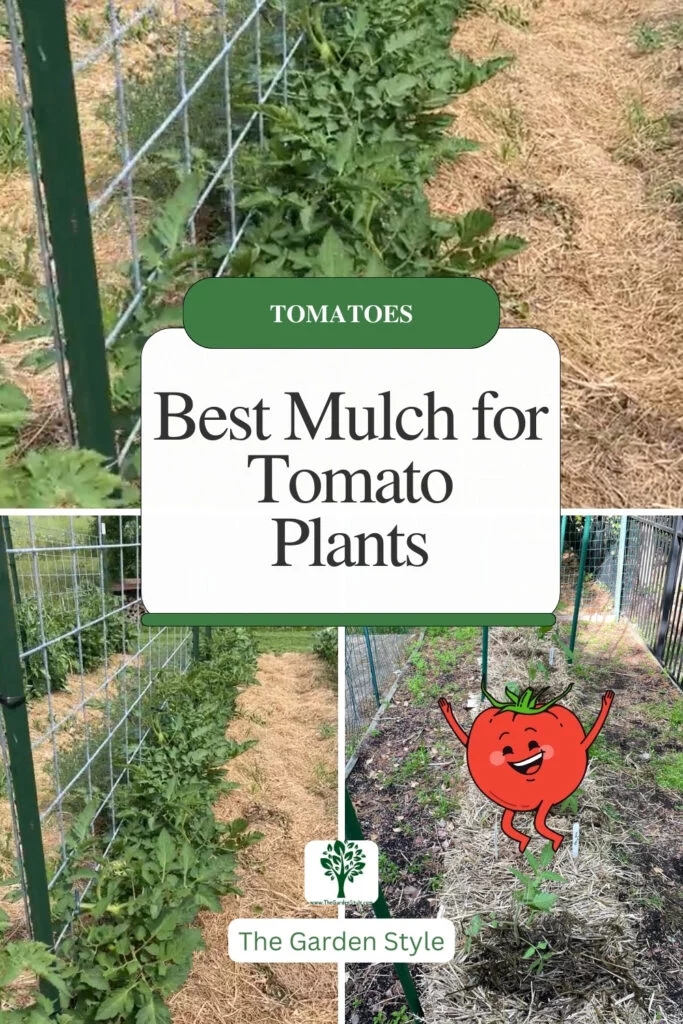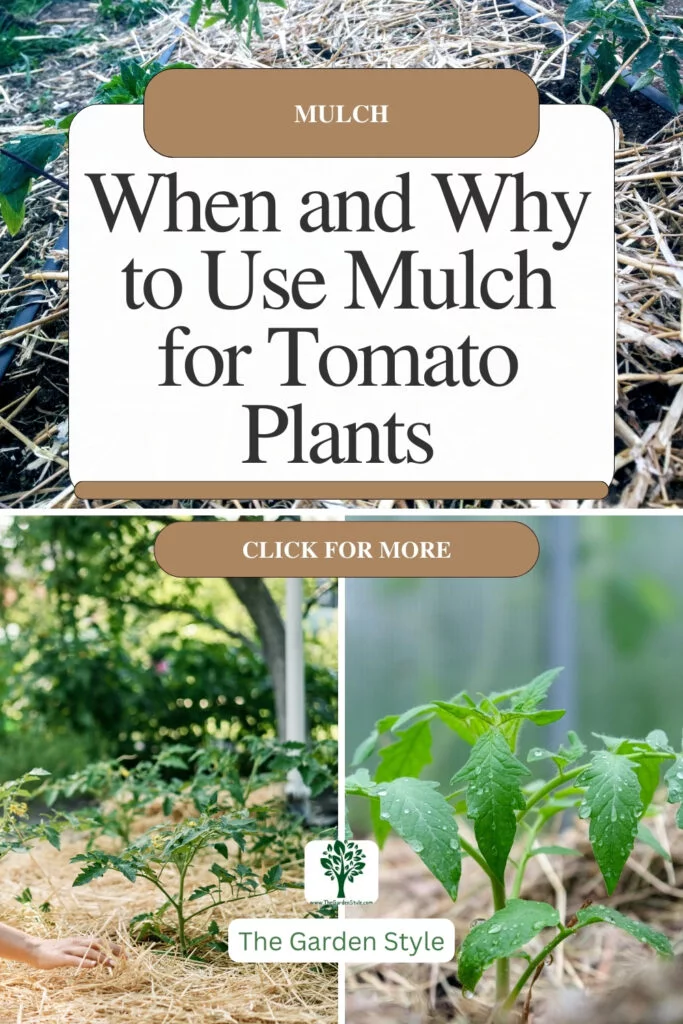For many gardeners, mulch is an indispensable tool for healthy tomato plants. But when is it truly needed? Understanding the benefits mulch provides and when it makes the biggest impact will help you use this gardening resource effectively. Let’s talk about when your tomato plants crave the comfort of mulch, how to choose the best mulch for tomato plants, how to mulch your tomatoes, and how many bags you will need.
Table of Contents
When and Why to Use Mulch for Tomato Plants
Think of mulch as a helping hand for your tomato plants in specific situations. Here are some key scenarios where mulch truly shines:
- Moisture Retention: Mulch acts like a sponge, absorbing and slowly releasing water, ensuring your plants stay hydrated, especially during hot and dry periods.
- Temperature Regulation: Mulch acts as an insulator, keeping the soil cool and preventing root stress during hot weather. Conversely, in cooler climates, mulch can help retain warmth in the soil, aiding early-season growth.
- Weed Control: Mulch creates a physical barrier, hindering weed seed germination and growth.
- Fruit Protection: Ripe tomatoes resting on bare soil are susceptible to rot and insect damage. Mulch creates a clean, dry surface for your fruits to rest on, promoting better quality and reducing spoilage.
The following table summarizes diverse scenarios where applying mulch may be beneficial when growing tomato plants.
| Scenario | Reason | Benefit |
| Hot and dry weather | Retains moisture | Prevents dehydration |
| Cool and early spring weather | Insulates soil | Promotes early growth |
| Presence of weeds | Suppresses weed growth | Reduces competition for resources |
| Ripe tomatoes on the plant | Creates a clean surface | Prevents rot and insect damage |
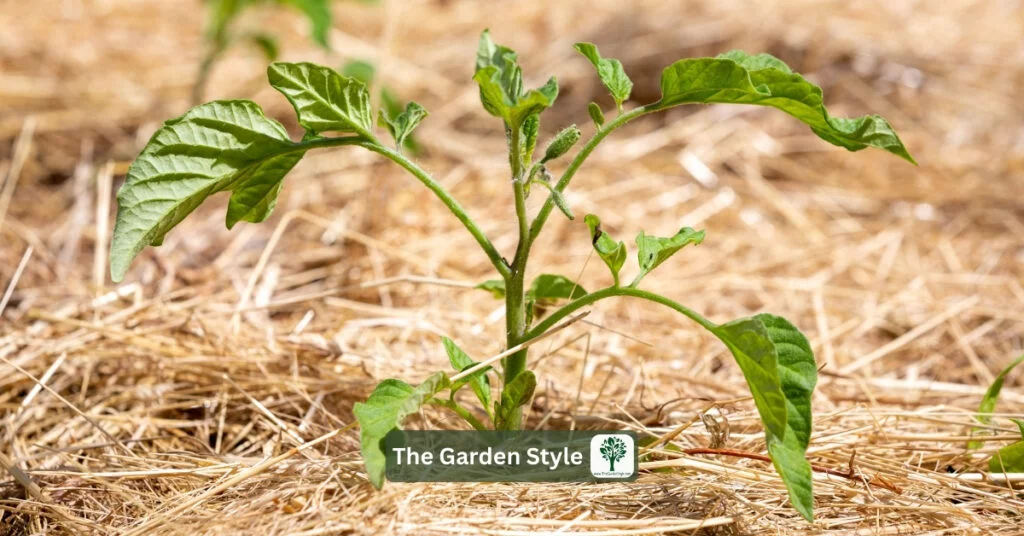
When Not to Mulch Tomato Plants
While mulch offers numerous benefits, it’s important to understand situations where it might not be necessary:
- Cool and wet climates: In areas with heavy rainfall and consistently cool temperatures, mulch can impede drainage and contribute to waterlogging, potentially harming your plants.
- Newly transplanted seedlings: Applying mulch too close to young seedlings can trap excess moisture around the stem, increasing the risk of fungal diseases. Wait until your plants are established and have a few sets of true leaves before mulching. Learn more about growing tomatoes from seeds and seedlings in this care guide.
- Raised bed gardens: Raised beds often have well-draining soil mixes, and the sides already act as barriers against weeds. In such cases, mulch may not be essential.
The following table summarizes situations where you should apply mulch on a tomato plant and where you should not do it.
| Use Mulch | Skip Mulch |
| Newly planted seedlings | Established mature plants |
| During hot, dry weather | Following heavy rains |
| In zones with hot summers | In perpetually cool, wet climates |
| With drip irrigation | With overhead watering system |
| To suppress weeds | In a sterile potting mix indoors |
| To conserve garden water | Where drought is not a concern |
Mulch Types Recommended for Tomato Plants
Now that you understand when your tomato plant needs mulch let’s explore different mulch options and their unique qualities:
Organic Mulches
Organic mulches decompose over time, adding nutrients to the soil as they break down. The table below summarizes the pros and cons of using organic mulches on tomato plants.
| Organic Mulch Type | Pros | Cons |
| Shredded leaves | Readily available, budget-friendly, improves soil aeration | It can deplete nitrogen as it decomposes, slow to break down fully |
| Wood Chip Mulch | Suppresses weed growth, retains moisture well, moderates soil temperature | It may contain weed seeds that can blow away in windy conditions |
| Straw Mulch | Lightweight, readily available, good weed suppression | Suppresses weed growth retains moisture well, moderates soil temperature |
| Grass clippings (untreated) | It can attract pests. Use sparingly around the base of the plant | It can mat together if applied thickly. Needs frequent application |
| Compost | Free, readily available, add nitrogen to the soil | Nutrient-rich improves soil fertility |
Inorganic Mulches
Inorganic mulches don’t decompose and offer a longer lifespan. The table below summarizes the pros and cons of using inorganic mulches on tomato plants.
| Inorganic Mulch Type | Pros | Cons |
| Black plastic mulch | Excellent weed control, warms soil in cooler climates | Traps heat in hot weather, hinders water penetration (requires drip irrigation) |
| Landscape fabric | Allows some water penetration, suppresses weeds | Can trap heat, limit air circulation |
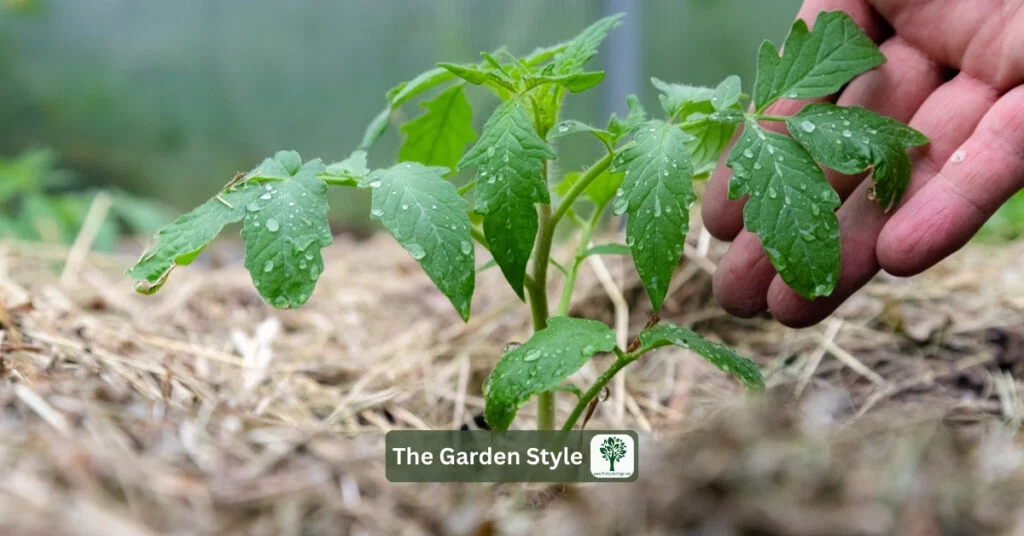
Choosing the Best Mulch for Tomato Plants
The ideal mulch for your tomato plants depends on your specific needs and climate. For a balance of weed suppression, moisture retention, and nutrient addition, organic mulches like shredded leaves or straw are generally preferred. However, if weed control is your top priority and you live in a cool climate, black plastic mulch can be a good option, as long as you use drip irrigation and monitor soil moisture closely.
Applying Mulch to Your Tomato Plants
Once you’ve chosen your mulch, here are some key steps for successful application:
- Wait until seedlings are in the ground before mulching. Putting mulch in place ahead of planting makes it harder to transfer delicate young plants into the bed without damage.
- Wait until the soil warms up: Apply mulch after the danger of frost has passed and the soil temperature reaches at least 60°F (15°C).
- Weed thoroughly: Remove any existing weeds before applying mulch to prevent them from thriving beneath it.
- Create a donut: Apply a 3–4 inch (7-10 cm) layer of mulch around the base of your tomato plant, leaving a few inches of space free around the stem. This prevents moisture from accumulating and potentially causing stem rot.
- Mulch has a tendency to shift, break down, or blow away over time. Check it routinely and add more as needed to maintain a protective 3-4 inch (7-10 cm) layer. Topping off your mulch ensures your plants see benefits throughout the whole season.
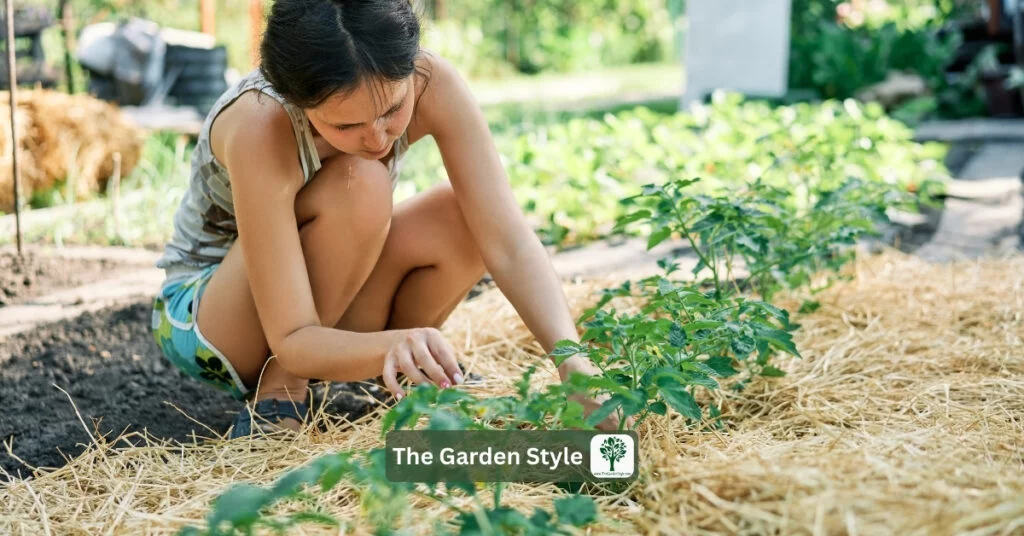
Frequently Asked Questions About Mulching Tomato Plants
Yes, mulching during the winter is beneficial for tomato plants. Mulch acts as insulation, protecting the soil and roots from extreme cold temperatures. It helps maintain a more stable soil temperature, preventing frost damage to your tomato plants.
Yes, newspaper can be used as mulch for tomatoes. It’s an eco-friendly option that suppresses weeds and retains moisture. However, ensure you layer it thick enough to be effective and consider combining it with other organic materials for better results.
Yes, over-mulching can be detrimental. It may lead to waterlogging, hinder proper airflow, and cause root rot. To avoid over-mulching, apply a layer that is 2-4 inches thick, leaving space around the plant’s base. Regularly monitor moisture levels, especially in rainy seasons, and adjust the mulch accordingly.
While most tomato varieties benefit from similar mulching principles, certain variations may influence your choice. For example, determinate varieties may require less mulch, while indeterminate ones may benefit from more substantial coverage. Tailor your mulching approach based on the specific needs of your tomato varieties.
Yes, mixing different types of mulch can be beneficial. Combining materials like straw, wood chips, and compost can provide a balanced mix of insulation, weed suppression, and nutrient enhancement. Ensure proper layering and compatibility to maximize the advantages of each type of mulch.
Aim for about 3-4 inches (7-10 cm) of mulch surrounding plants. Any less won’t fully suppress weeds or retain moisture. Over 6 inches prevents water and air from penetrating down to roots.
For a quick and accurate estimate of how much mulch you need for your tomato plants, we recommend using our Mulch Calculator on The Garden Style. Simply input the dimensions of the area around your tomato plants that you plan to mulch. Include the length and width in the provided fields, then the thickness of the mulch layer you desire or our suggestion (3 inches depth). After that, choose the type of mulch you prefer or plan to use. Click the calculate button to receive an instant estimate of the number of bags or cubic yards of mulch required for your tomato plants. Very simple! Just follow the link to The Garden Style Mulch Calculator Tool.
No. Pull mulch about an inch away from plant stems. Direct contact can cause moisture-related disease issues in plants.
Plastic mulches aren’t great for home gardens, as they don’t improve soil over time. However, black plastic does offer excellent weed prevention and soil warming early on.
It’s best not to use fresh grass clippings around edibles. They can harbor herbicide residues and other contaminants. Composted clippings are safer. Shredded leaves or straws are the best mulch for tomato plants.
Yes, even potted patio tomatoes benefit from an inch or two of light mulch over their soil. It reduces water needs and keeps roots cooler.
Conclusion
For tomato gardeners who are short on time or dealing with challenging conditions, mulch can be a valuable ally. Stop untended weeds from stealing the show, build water-retentive soil, and moderate exposure to weather extremes. With so many positives, it’s easy to see why mulch belongs in any thriving tomato patch. Don’t be afraid to spread this organic blanket generously around your prized plants. A few wheelbarrows full of mulch is a small price to pay for a bumper tomato harvest!
If this post about the best mulch for tomato plants was helpful, please share it:
